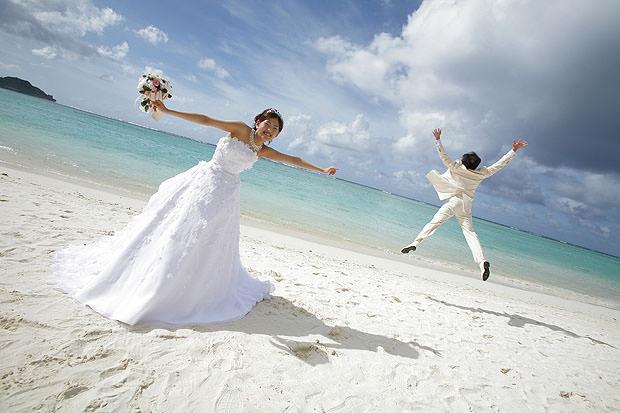Weddings are a once in a lifetime (hopefully!) occasion, and a day that the bride and groom will cherish forever. Wedding photos play a large part of this, but this can also put a huge amount of pressure on the photographer - missing a shot simply isn't an option.
While wedding photography is possibly the most stressful challenge a photographer can face, it can also be one of the most rewarding. If you're lucky, it might even lead to a lucrative and enjoyable career.
If you've been asked to photograph someone's big day, or if you're interested in gaining some experience with an eye to making it your profession, follow these tips to make sure everything goes as smoothly and stress-free as possible.
Weddings are a lot of fun but can be hugely stressful for the photographer. Image by Hiroki Nakamura.
Are You Sure?
Wedding photography can be very stressful and lots of hard work. The first thing to decide is whether you actually want the responsibility. If you've been asked to photograph a friend's wedding, remember that you can always say no.
It's a good idea to gain some experience before going it alone as a wedding photographer - see if there's a local photographer who will let you tag along and observe; just remember to stay well out of their way, and don't expect to get paid. You'll then be much better prepared when it comes to your first solo shoot.
Be Prepared
Weddings are very busy and hectic, so preparing for your shoot in advance is essential. Start by getting an itinerary of the day so you know exactly where you have to be and when. Visit the venues (church, reception hall etc) before the big day so you know how to get there and how to get around.
This is also the time to start scoping out good photo opportunities. If possible, take a couple of friends to pose for some test photos, or even better take the wedding couple so you can discuss what they like and don't like.
Make a Shot List
Sit down with the wedding couple and make a list of all the photos they are expecting in the final album - everything from the group family photo to the snapshots of Auntie Marj. Although it can be a tedious process, on the day this list will be your saviour, helping you to stay focused among the hustle and bustle.
A shot list will help you stay calm, and ensure you don't miss any crucial photos. Image by Jonathan Day.
Let the Guests Do the Hard Work
A great idea is to put disposable cameras on all the tables at the wedding reception meal so that the guests can take their own snapshots of the day. This will provide you will a whole bunch of photos for no effort on your part, which you can use to compliment your more professional shots, or even use to make a separate album altogether. You might also find that the guests feel more comfortable being photographed by their own friends and family, particularly after a few glasses of wine!
Take Two Lenses
You'll want to pack a couple of different lenses for the wedding day - a wide angle lens for interiors and group shots, and a longer lens for candid shots and portraits.
Even better than using two lenses is to use two cameras, saving your precious time changing lenses and reducing the chances of you dropping a lens.
Batteries and Memory Cards
The absolute worst thing that can happen when photographing a wedding is running out of power or memory card space (or film). Can you imagine asking the vicar if he wouldn't mind postponing the ceremony for half an hour while you recharge your batteries? No, neither can I!
Take at least two batteries (fully charged) and enough blank memory cards - you'll be taking lots of photos and you won't have time to delete unwanted shots on the day.
By stocking up on batteries and memory cards you'll also give yourself the peace of mind to concentrate on what really matters - taking photos.
It's All In the Detail
As well as the more obvious photos (bride and groom kissing, family group photo etc), be on the lookout for the small details that add character and depth to the album. Close-ups of the rings, bouquets of flowers, or hanging dresses are all important reminders of the day, and they also allow you exercise a little more creativity than some of the more common wedding photos.
Get creative and photograph some interesting details to put a unique spin on the album. Image by Tim Forbes.
Inject Some Humour
At weddings, people often get caught up in the formal side of things. Unfortunately this can cause them to act in a "prim and proper" way that doesn't allow their personality to shine through. Watch for those brief moments where they let their hair down, such as the bride taking her shoes off to rub her weary feet, the best man pulling a funny face, or a baby chewing on a bridesmaid's bouquet. These can often be some of the most personal and memorable photos of the day.
Silence Your Camera
There's nothing more distracting during a wedding ceremony or speech than the sound of your camera bleeping away as it tries to focus. Be sure to turn off your camera's sound at the start of the day and leave it off.
A silent camera also makes it easier to shoot candid photos without alerting your subject, allowing you to get a much more natural photo.
Have Fun
Finally, remember that weddings are a time for celebration and fun. Although they can be stressful for the photographer, make sure that you take the time to let your hair down a bit, have a chat with the guests, and enjoy yourself.

